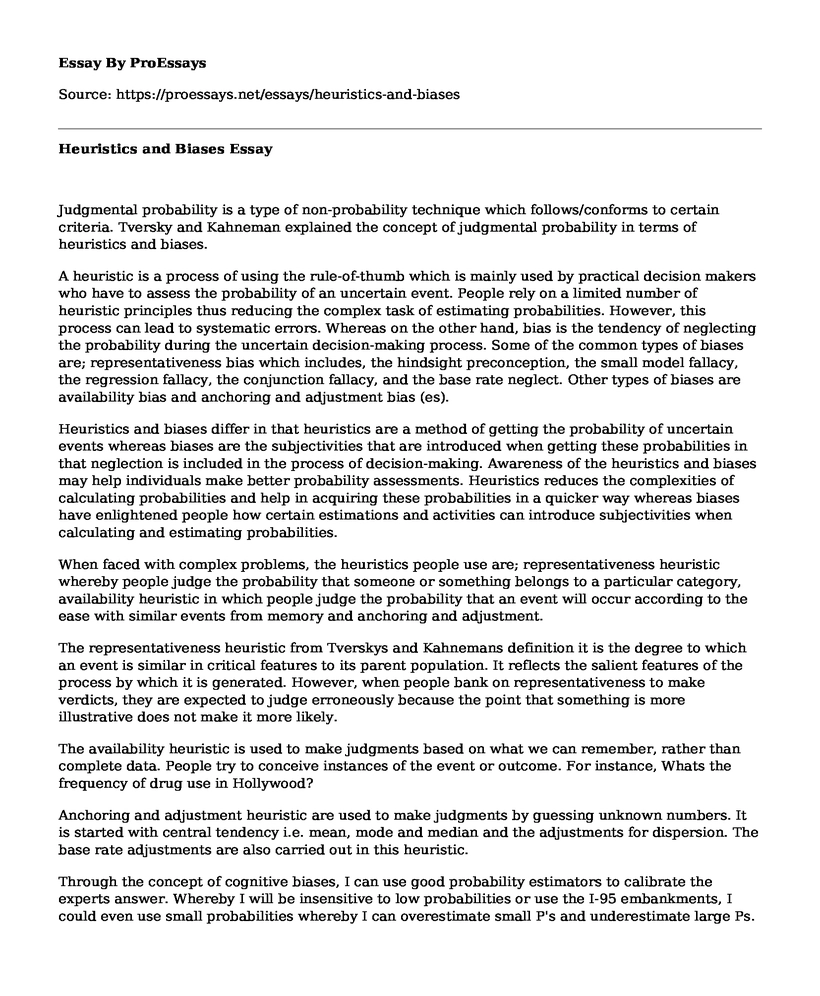Judgmental probability is a type of non-probability technique which follows/conforms to certain criteria. Tversky and Kahneman explained the concept of judgmental probability in terms of heuristics and biases.
A heuristic is a process of using the rule-of-thumb which is mainly used by practical decision makers who have to assess the probability of an uncertain event. People rely on a limited number of heuristic principles thus reducing the complex task of estimating probabilities. However, this process can lead to systematic errors. Whereas on the other hand, bias is the tendency of neglecting the probability during the uncertain decision-making process. Some of the common types of biases are; representativeness bias which includes, the hindsight preconception, the small model fallacy, the regression fallacy, the conjunction fallacy, and the base rate neglect. Other types of biases are availability bias and anchoring and adjustment bias (es).
Heuristics and biases differ in that heuristics are a method of getting the probability of uncertain events whereas biases are the subjectivities that are introduced when getting these probabilities in that neglection is included in the process of decision-making. Awareness of the heuristics and biases may help individuals make better probability assessments. Heuristics reduces the complexities of calculating probabilities and help in acquiring these probabilities in a quicker way whereas biases have enlightened people how certain estimations and activities can introduce subjectivities when calculating and estimating probabilities.
When faced with complex problems, the heuristics people use are; representativeness heuristic whereby people judge the probability that someone or something belongs to a particular category, availability heuristic in which people judge the probability that an event will occur according to the ease with similar events from memory and anchoring and adjustment.
The representativeness heuristic from Tverskys and Kahnemans definition it is the degree to which an event is similar in critical features to its parent population. It reflects the salient features of the process by which it is generated. However, when people bank on representativeness to make verdicts, they are expected to judge erroneously because the point that something is more illustrative does not make it more likely.
The availability heuristic is used to make judgments based on what we can remember, rather than complete data. People try to conceive instances of the event or outcome. For instance, Whats the frequency of drug use in Hollywood?
Anchoring and adjustment heuristic are used to make judgments by guessing unknown numbers. It is started with central tendency i.e. mean, mode and median and the adjustments for dispersion. The base rate adjustments are also carried out in this heuristic.
Through the concept of cognitive biases, I can use good probability estimators to calibrate the experts answer. Whereby I will be insensitive to low probabilities or use the I-95 embankments, I could even use small probabilities whereby I can overestimate small P's and underestimate large Ps.
Cite this page
Heuristics and Biases. (2021, Mar 12). Retrieved from https://proessays.net/essays/heuristics-and-biases
If you are the original author of this essay and no longer wish to have it published on the ProEssays website, please click below to request its removal:
- The Differential Diagnosis of Attention Deficit Hyperactivity Disorder (ADHD) And Sensory Modulation Disorder (SMD)
- The Growth of Social Gerontology Essay
- Gender Identity: A Natural Part of Adult Personality - Essay Sample
- Athletics and Social Life: Examining the Impact of College Athletics - Essay Sample
- Interview With Mr. Smith Davis to Reduce Poverty in Country - Essay Sample
- Rise in Stress for Saudi Students in US Universities: Research Paper
- Essay Sample on The Abolitionist Movement: Ending Slavery and Fuelling Debate







